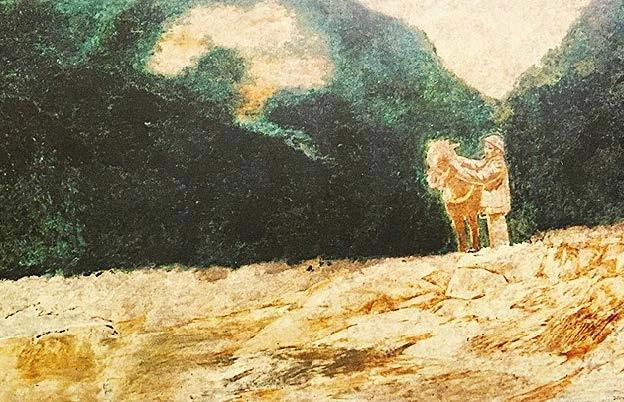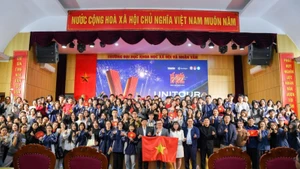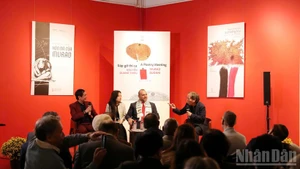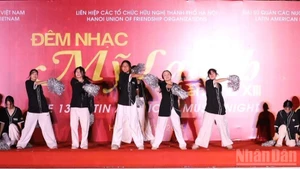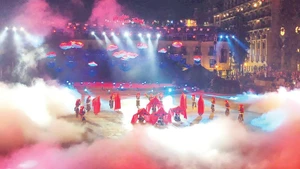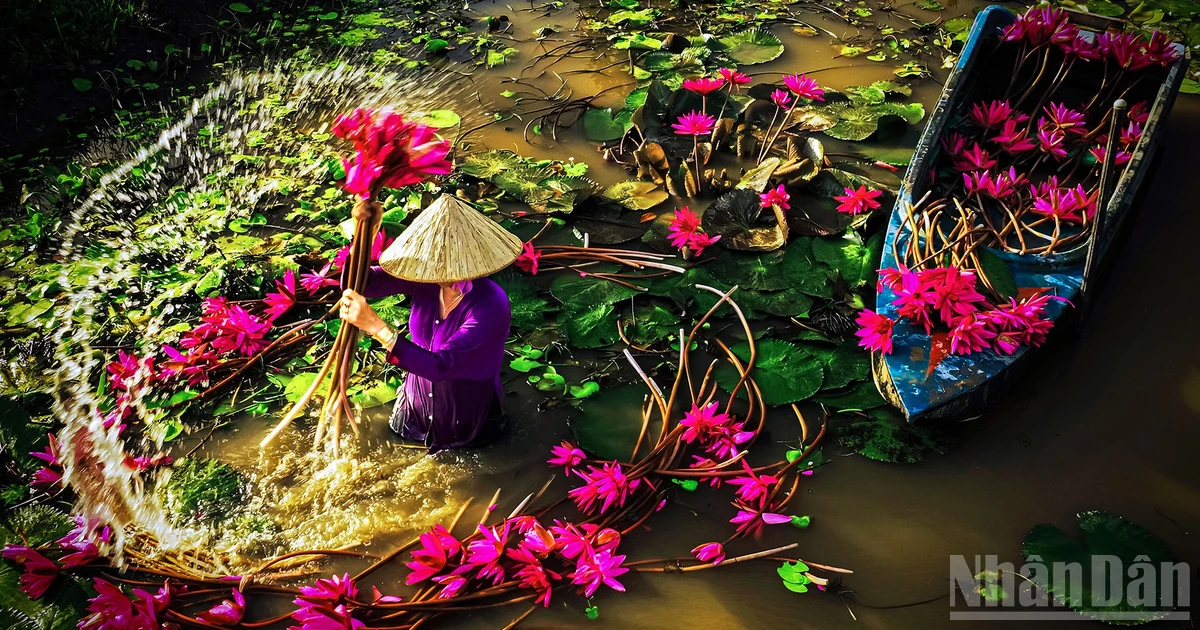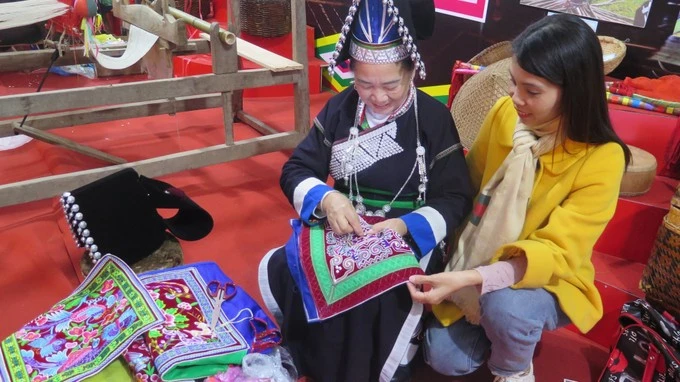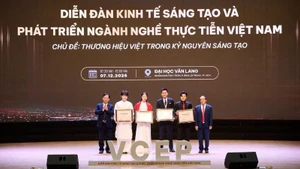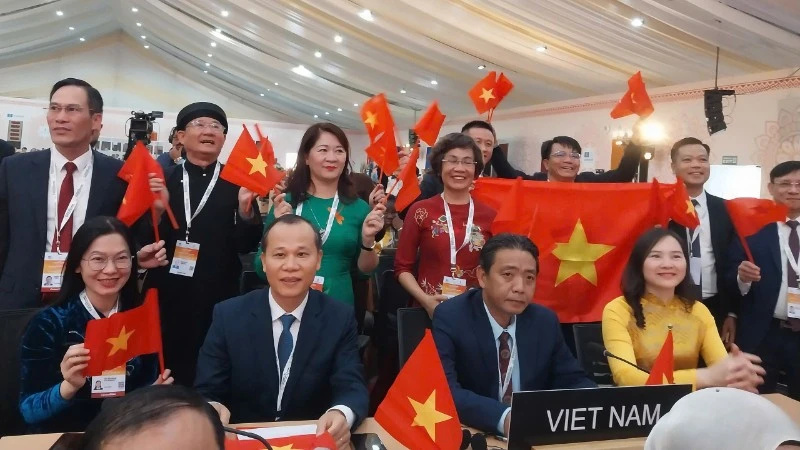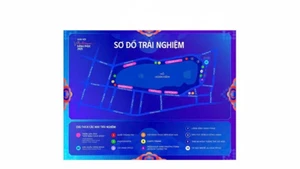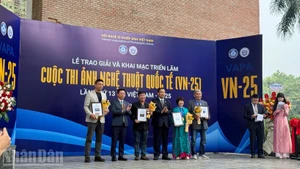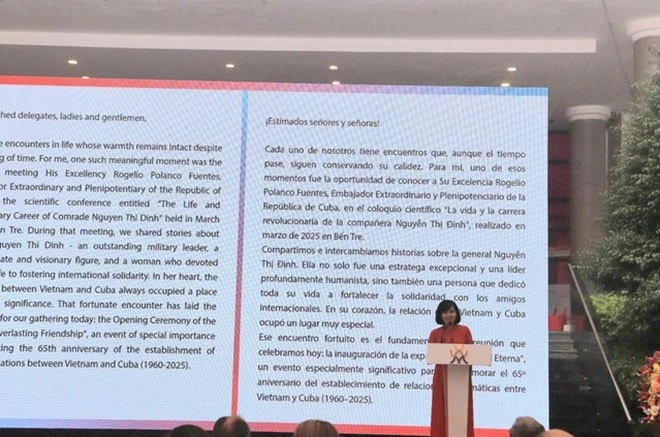Master artists portraying Uncle Ho
Many renowned artists from the Indochina College of Fine Arts, as well as artists who joined the resistance and were deeply passionate about portraying Uncle Ho, created numerous famous works. These include: Uncle Ho in the Viet Bac war zone (lacquer painting, Duong Bich Lien — recognised as a National Treasure and displayed at the Vietnam Fine Arts Museum), President Ho Chi Minh with children (woodcut, To Ngoc Van), Uncle Ho on a mission (silk, Nguyen Thu), Tonight Uncle doesn't sleep (woodcut, Nguyen Nghia Duyen), Uncle's house at the Presidential Palace (oil, Luong Xuan Nhi), Portrait of Uncle Ho (oil, Tran Van Can), Uncle Ho writing poetry at Pac Bo (sketch, Phan Ke An), and more.
The first artist drawing President Ho Chi Minh from life during the fervent revolutionary days in Ha Noi in October 1945 was Van Giao (1916–1996), a pioneer of Vietnamese revolutionary art who dedicated his life to portraying Uncle Ho.
Having the opportunity to meet Uncle Ho in person and live and paint in places where Uncle Ho had lived and worked—such as his hometown in Nghe An, Pac Bo, and Cao Bang — Van Giao used emotional realism to create works that touched the hearts of many Vietnamese and left a lasting mark on revolutionary art. His works include Portrait of President Ho Chi Minh, Uncle Ho writing the Declaration of Independence, Uncle Ho visiting his hometown, among others.
The history of Vietnamese fine arts also remembers the moving story of a painting of Uncle Ho done in blood by a southern youth after the August Revolution. That young man was painter and sculptor Diep Minh Chau (1919–2002). With a small photo of Uncle Ho cut from a newspaper, which he treasured in his wallet close to his heart, he painted portraits of Uncle Ho wherever he went.
In mid-1950, Diep Minh Chau came to Viet Bac to take up a new assignment. He was fortunate to live near Uncle Ho, carefully studying his appearance and soul. Devoting all his energy to capturing Uncle Ho's essence, he created a series of notable works: The layout of Uncle Ho's house on the hill (silk), Uncle working in a stilt house in Viet Bac (oil), Uncle fishing by the stream (oil), and Midday sunlight in front of Uncle Ho’s house (oil).
Notably, he sculpted many statues of Uncle Ho, including the bronze statue President Ho Chi Minh with children (placed in front of the Ho Chi Minh City People's Committee headquarters on the occasion of the 100th anniversary of Uncle Ho’s birth).
Diep Minh Chau was among the first generation of Vietnamese revolutionary sculptors and modern sculpture pioneers. He was also the only sculptor to receive the Ho Chi Minh Prize in its first round (1996) for a group of works, most of which portrayed Uncle Ho, including: President Ho Chi Minh and children from the north, centre and south (blood-painted silk, 1947); Uncle Ho by the Lenin stream (plaster, 1980); and Uncle Ho with children (bronze statue, 1993).
Throughout the revolution, national liberation, and nation-building, President Ho Chi Minh was portrayed vividly across many media and materials. Despite differing techniques and styles, all works reflect the simplicity, nobility, and luminous spirit of his thought, morality, and lifestyle.
Continuing creative stream
Following in the footsteps of past masters, later generations of artists have continued creating artworks about President Ho Chi Minh, mostly in the form of propaganda posters, digitally printed and based on documentation, with themes such as Uncle Ho with children, soldiers, workers, and farmers.
In sculpture, a number of young sculptors continue to explore the theme, including Le Lang Luong, Khong Do Tuyen, lecturers from the Vietnam University of Fine Arts with their colleagues.
Le Lang Luong shared that he had collaborated on many Uncle Ho monument projects, some of which received awards — such as the Monument of Uncle Ho with Central Highlands ethnic groups and Uncle Ho with the people of Tuyen Quang. However, his two most cherished works are the statue of Uncle Ho at the Kim Lien Relic Site in Nam Dan, Nghe An (2021), and the statue currently underway in Tan Trao, expected to be completed on August 19.
The work in the Kim Lien display hall is moderately sized (1.9 metres tall), cast in bronze. Uncle Ho visited his hometown twice — in 1957 and again in 1961. The second visit, also his last, was marked by emotional reflection: although he returned as the president of an independent nation, he faced an empty family altar. From this deep emotion, the artist sculpted an image of Uncle Ho holding a cigarette, eyes glistening, walking with restrained, contemplative steps.
Currently, the statue in Tan Trao led by Le Lang Luong is being rushed to completion and will be placed at the square of the Tan Trao Special National Relic Site in Tuyen Quang province on August 19. The statue, 7.5 metres tall (12 metres including base), cast in bronze, depicts Uncle Ho at Na Nua hut in July 1945 — at a moment of crucial decision, embodying the will of the Party and the people to launch the August Revolution.
Marking the 135th birth anniversary of President Ho Chi Minh, the Statue of Uncle Ho visiting his hometown, by Le Lang Luong, Khong Do Tuyen and colleagues, has just been unveiled. It is placed at the Sen Village Stadium, in the President Ho Chi Minh Memorial Site in Kim Lien Commune, Nam Dan District, Nghe An Province. The large-scale bronze statue (7.9 metres tall) was cast using modern technology and portrays Uncle Ho in his 1961 homecoming — modest, simple, and full of emotion.
In recent years, the Ministry of Public Security has initiated the creation of several statues of President Ho Chi Minh as gifts to localities and units. Alongside the Statue of Uncle Ho visiting his hometown in Nghe An, the Statue of Uncle Ho in Tan Trao is also being urgently completed to present to Tuyen Quang Province on August 19, marking the 80th anniversary of the Tan Trao National Congress. Another statue — Uncle Ho and the National Day of Festival — is also planned as a gift to Phu Tho Province on the occasion of the Hung Kings’ Festival in 2026.
These monuments to President Ho Chi Minh are not only valuable in terms of history, culture, and architecture, but also serve as "red addresses" that honour his contributions and help educate younger generations about the revolutionary traditions of Viet Nam.
